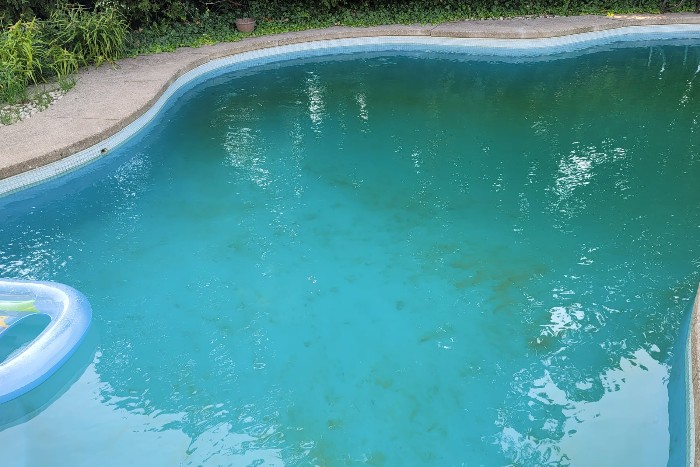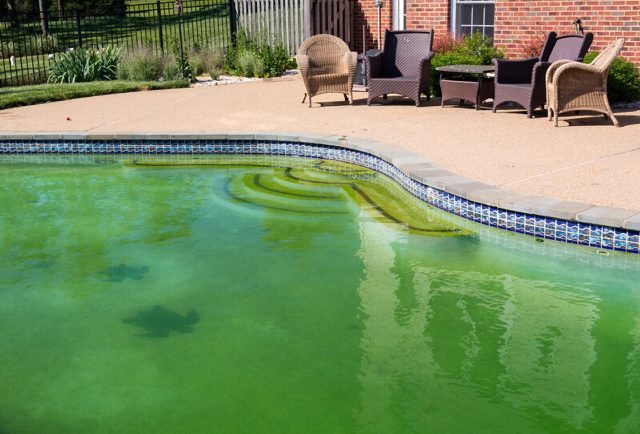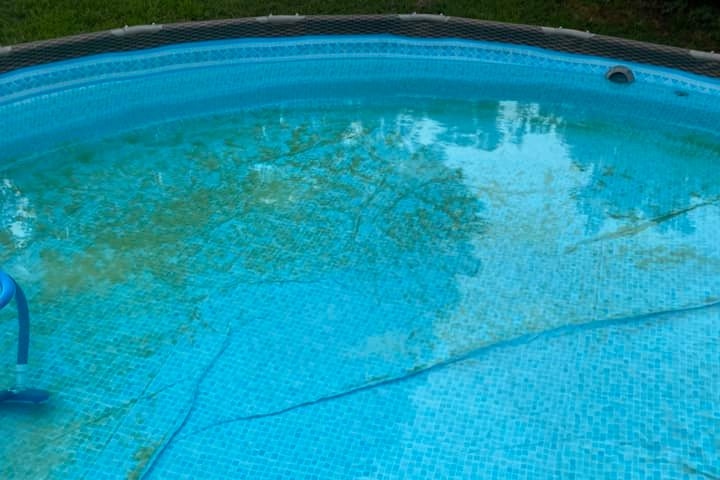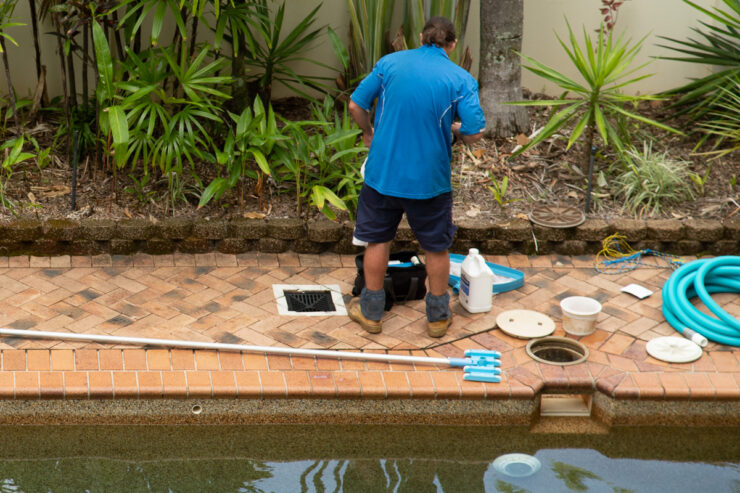Mustard algae, also known as yellow algae, is a bacteria that, once formed, is hard to get rid of. The usual method of shocking your pool to get rid of algae will not work for yellow algae because it is resistant to chlorine. You’ll know if you have yellow algae by its appearance and if it is clinging to your pool walls.

Yellow (mustard) algae are greenish-yellow in color, and this is because it’s derived from green algae. You should treat it immediately, as it can cause serious staining on your pool and because it’s high in bacteria content.
Below we list five algaecides for treating yellow algae, all featuring different traits. Which traits are best for your pool will determine which algaecide you treat your pool with.
Article Contents
Our Top 5 Algaecides For Mustard or Yellow Algae in Pool
1. Kemtek 60 Percent (Our Top Pick)
2. United Chemicals Yellow Treat (Best For The Price)
3. In The Swim Swimming Pool Algaecide 60 Plus (Best For Prevention)
4. Lo-Chlor Algaecide (Best Long-Lasting)
5. Yellow Out (Fastest Acting)
Algaecides For Mustard or Yellow Algae in Pool Compared
| Image | Product | Features | Link |
|---|---|---|---|
Our Top Pick  |
| 9.7 | Check Price |
Best For The Price  |
| 9.5 | Check Price |
Best For Prevention  |
| 9.1 | Check Price |
Best Long-Lasting  |
| 8.8 | Check Price |
Fast Acting  |
| 8.6 | Check Price |
The Difference between Green Algae and Yellow Algae
Green algae is the most common form of algae, and mustard or yellow algae is a derivative of green algae. Yellow algae is a form of green algae that has become resistant to chlorine, the most effective way of killing green algae.

While green algae grow in hot, stagnant areas, yellow algae grow in shady spots. Yellow algae typically bloom with low filtration and/or low chlorine levels. Keeping your pool chemically balanced is the best way to prevent mustard algae outbreaks.
Green algae tend to float on the surface of the pool. Yellow algae, on the other hand, has a tendency to stick to surfaces like the walls, floor, and stairs of a pool. Yellow algae can look like sand or dirt; it’s a common mistake to make. But if it’s clinging to the walls, it’s more than likely yellow algae.
Yellow algae are resistant to chlorine, so it is so hard to treat. To treat mustard algae, it is best to look for a treatment that treats and prevents future algae blooms rather than the fastest working product. That being said, fast-acting products also work well at preventative maintenance.

Another key difference between green algae and yellow algae is that, even after it is fully treated, yellow algae is prone to repeatedly coming back.
When I treat mustard algae, I prefer using a three-month algaecide for this reason. Which means I only have to treat the pool every three months. But, if a pool has had yellow algae, I’ll treat it again within two months, just to be on the safe side.
How Do Algaecides Work?
Algaecides are pool chemicals that kill algae or prevent them from growing in a pool. These chemicals stop vital life processes like photosynthesis and burst algae cell walls.
Algaecides start to work within a few hours and up to two days, depending on the severity of the algae bloom. You can also use algaecide as a preventative measure against algae blooms by adding it to your pool each time you shock it.
Different broad categories of algaecides exist quaternary ammonium compounds (aka quats), polyquats, and copper salts. Each of these has distinct characteristics for fighting algae, and knowing a little about them will greatly help you pick the correct algaecide for yellow algae.
- Quats are a surfactant that is also used in soaps and detergents. They cause the algae cell walls to split so the chlorine can kill it. If you use too many quats, the water will foam.
- Polyquats are similar to squats, except they don’t foam. The downside is that they are a little more expensive than quats.
- Copper salts contain copper compounds, complexes, and chelates. Copper is an effective algaecide but can also cause staining over time.
What Do You Look For In The Best Algaecide For Yellow Algae?

As with all pool chemicals, there are certain traits to look for to ensure the chemical works effectively. Yellow algae is the hardest form of algae to get rid of because it has become resistant to chlorine. So, it’s important to look for these features when comparing algaecides for yellow algae:
- The product has been specifically tested on yellow algae
- Make sure the algaecide contains sodium bromide
- Long-lasting (90 days or longer)
- Preventive ingredients for future blooms
Non-staining and non-foaming. For mustard algae, I prefer an algaecide that prevents future algae blooms and treats the current problem. This doesn’t concern me as much with green algae because it won’t come back once it’s gone, and the pool’s chemicals stay balanced. Since yellow algae are so much stronger, I want to make sure that it doesn’t rebloom.
That said, if I have a small bloom and the pool doesn’t get a lot of shade, I’ll go for a quick treatment and retreat to the affected area within 1-2 months to be safe. As pool owners know, all pools are unique, and treatments work for different things.
Best Algaecides For Yellow Algae Reviewed
The best algaecides on this list cover what to look for in algaecides for yellow algae. This is because not every treatment plan is one size fits all. So, there are different algaecides here for a variety of uses.
1. Our Top Pick: Kemtek 60 Percent
- Kills algae and prevents regrowth (highest strength available)
- Safe with all pool, spa filter types (salt, chlorine)
- Helps clarify pool water & doesn't foam
Kemtek 60 Percent ranks as my favorite algaecide for yellow algae because it covers a lot of ground in what you’re looking for in a treatment plan. It’s safe for all pool sanitizers (chlorine, bromine, and salt), is long-lasting, and treats and prevents yellow algae and other variations.
This algaecide is a polyquat, which means it doesn’t foam, so you don’t have to worry if you need to add a lot for treatment. Being a polyquat, it’s affordable and contains no copper, so you don’t have to worry about staining.
Kemtek is odor free, and the gel-like algaecide isn’t harmful to your skin. It works relatively fast (under 2 days), and it also treats other types of algae. This is your best option if you’re unsure what algaecide to get.
- Long-lasting
- Treats multiple strains of algae
- Decent price
- For severe yellow algae, it may take two bottles, but this is rare
2. Best For The Price: United Chemicals Yellow Treat
- Eradicates yellow & mustard algae
- Compatible with: Chlorine (including salt generator) & bromine (plaster, fiberglass, vinyl)
- Works in 24 hours & doesn't deplete chlorine
United Chemicals Yellow Treat is a granular algaecide compatible with chlorine and salt-chlorinated pools. It’s a great product for the price point, especially considering that 5 ounces covers 10,000 gallons of water and comes in a 2-pound bag. It’s missing a water clarifier, so adding a couple of bags of shock during treatment is best.
Yellow Treat doesn’t contain copper, so you don’t have to worry about staining. This algaecide is designed to treat current algae and is not a preventative measure. Still, it’s a worthy product at a decent price that will kill any yellow algae that is present.
- An effective algaecide at a fair price
- Works within 2 days
- Not long-lasting
- Does not prevent future algae blooms
3. Best For Prevention: In The Swim Swimming Pool Algaecide 60 Plus
- Treats algae including: green, yellow (mustard), black, and pink
- Non-metallic, non-foaming, low odor
- Compatible with chlorine, bromine, biguanide, and salt systems
In The Swim Algaecide 60 Plus is one of the best algaecides on the market. Much like Kemtek, this is a multi-use algaecide with little odor, no metals, and it doesn’t foam. What I like about this algaecide is that it is pH tolerant, so it won’t affect the pH level in your pool during treatment.
Kemtek edges this out because it uses less dosage to treat yellow algae. Still, this is a solid choice if you’re looking for a multi-use algaecide.
- Treats multiple strains of algae
- Low odor
- Works within 2 days
- Takes 11 ounces to treat 10,000 gallons of water, whereas other algaecides take only 5 ounces
4. Best Long-Lasting: Lo-Chlor Algaecide
- Good for Blue-green, yellow (mustard) & black algae.
- Treats algae for 90 days
- Slow release for ongoing protection
Lo-Chlor is a polyquat algaecide that lasts up to three months with a single treatment. I have used it before, and I only had to use it once. This is a great treatment to use if you’re shutting your pool down for the winter and are susceptible to yellow algae. It’s also an effective preventative product for black algae as well.
5. Fastest Acting: Yellow Out
- Kills yellow (mustard), green, brown, pink algae
- Safe on plaster, fiberglass, vinyl and saltwater pools
- Kills algae in 24 hours
Yellow Out is a fast-acting, multi-purpose algaecide that will clear your pool in less than 24 hours. Part of the reason is that it is super chlorinated, so it shocks and clarifies your pool at the same time. This is an effective product that I recommend for most treatments.
Yellow out is granular and needs to be mixed in a 2.5-gallon bucket before adding to the pool for best results. Although you could probably get away with using two bags for 10,000 gallons of water, it’s best to use three.
- It’s safe to swim in your pool within 8 hours
- Clarifies water during treatment
- Decent price
- Have to use a lot of the product
- Is not multi-use
- Best results when used at night
Final Thoughts On The Best Algaecides For Yellow Algae in Pool
Yellow algae are resistant to chlorine, which makes getting rid of it difficult. However, specific products on the market work specifically for yellow algae and also treat other algae strains. The key feature is whether it is a quat, polyquat, or metal-based algaecide.
Since yellow algae are so resilient, the chances are good that they will return. You want an algaecide that is long-lasting and will also aid in preventing future outbreaks. Unless you are using a three-month treatment for algaecide, I will treat the pool again within two months with a preventative algaecide, especially if your pool has shaded areas.

